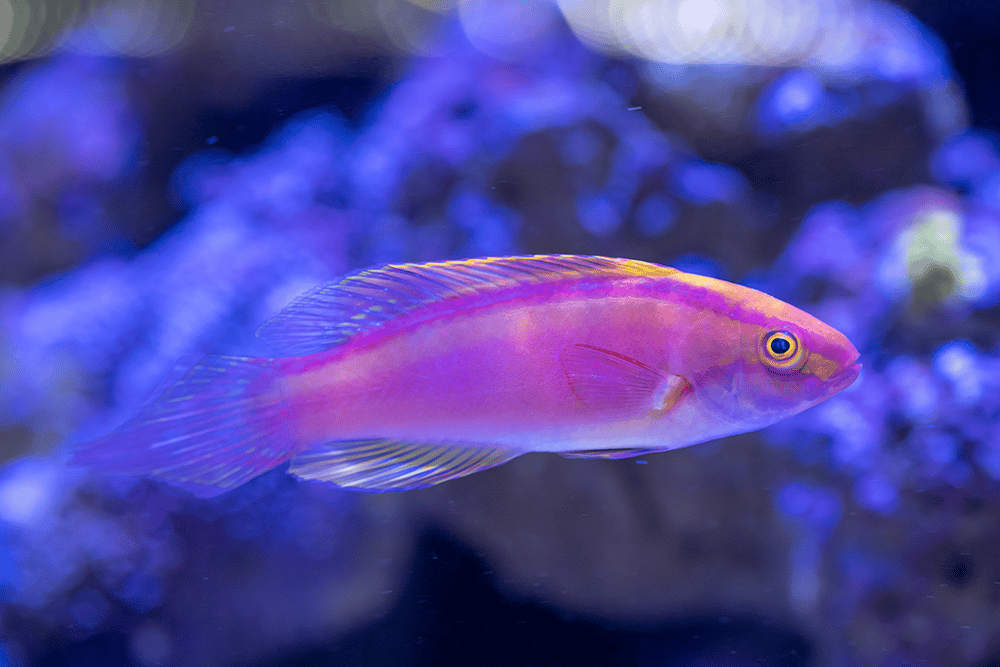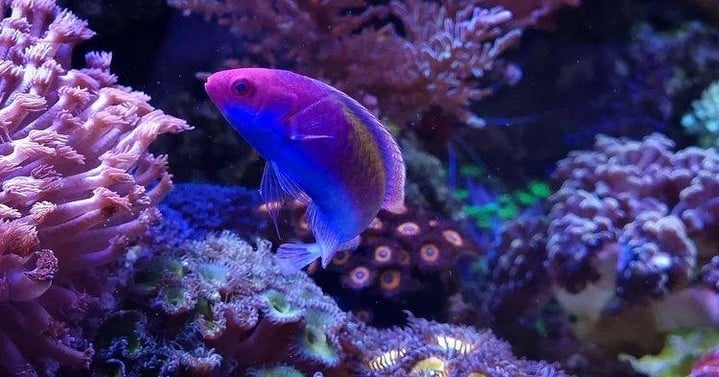Chalice Coral: A Comprehensive Guide for Beginners
Corals are not just beautiful creatures that add color to an underwater world, but they also play a vital role...
Jim Sabellico
July 12, 2022

Cirrhilabrus spp.
4-6 inches (10.2-15.2cm)
Beginner
Lined fairy wrasse, Rhomboid fairy wrasse, Lubbock’s fairy wrasse, and red-margined fairy wrasse
Carnivore
8.1-8.4
The fairy wrasse is a beautiful and delicate fish that requires special care if you want to keep it healthy and happy. In this care guide, we will discuss everything you need to know in order to provide your fairy wrasse with the best possible care.
We will cover everything from tank size and water parameters, to food and breeding. So if you are thinking of adding a fairy wrasse to your aquarium, read on for all the information you need!
The fairy wrasse is a reef-associated fish found in the Indo-Pacific region. It is most commonly found in deeper reefs, living in areas with plenty of caves and overhangs. The fairy wrasse is a peaceful fish and gets along well with other aquarium inhabitants.
It is an active swimmer and does best in a tank with plenty of live rock for hiding and exploring. Fairy wrasses are one of the most popular fish kept in saltwater aquariums. They are known for their vibrant colors and interesting patterns.
The males are especially brightly colored, while the females are drabber. Fairy wrasses are also one of the few fish that change sex from female to male as they mature.
Fairy wrasses are small, brightly colored fish with elongated bodies and colorful fins. Most fairy wrasses grow to be around 3 inches (7.5 cm) long, although some species can reach up to 6 inches (15 cm).
All fairy wrasses have streamlined bodies that taper towards the tail. Their deeply forked tails make them excellent swimmers and help them maneuver quickly through the water.
They are named for their bright colors and patterns which can include shades of blue, green, yellow, purple, and orange. Male Fairy Wrasses are typically more brightly colored than females and have longer fins.

On average, a Fairy Wrasse will cost anywhere from $29.99 to as much as $79.99. The price of a Fairy Wrasse will depend on the specific type, the breeder/supplier, and their overall availability.
When it comes to buying a Fairy Wrasse, it is important to find a reputable breeder or supplier. Not only will this ensure that you are getting healthy fish, but it will also help to avoid any potential scams.
Keep in mind that these fish are relatively delicate, so it’s important to purchase them from a reputable dealer who can provide you with proper care instructions. It’s also a good idea to ask around at your local fish store or online forums to get recommendations for good sources of fairy wrasses.
The recommended tank size for a Fairy Wrasse is at least 30 gallons. If you are keeping a pair, you’d need at least 55 gallons. However, one important factor to consider when keeping a Fairy Wrasse is its swimming speed and activity level. A larger tank will be more comfortable for an active swimmer like the Fairy Wrasse.
Fairy Wrasses are carnivores and require a diet of meaty foods. They will accept most frozen and live foods, as well as flakes and pellets. It is important to offer a variety of foods to ensure that they are getting all the nutrients they need.
Some good food options for Fairy Wrasses include Mysis shrimp, brine shrimp, bloodworms, and krill. You can also offer them frozen foods that are designed for carnivores, such as Ocean Nutrition Formula Two and Hikari Marine Cuisine.
Fairy Wrasses should be fed two to three times a day. They are relatively small fish and have high metabolisms, so they need to eat often. It is best to offer them small meals throughout the day rather than one large meal. This will help prevent them from becoming overweight and will also help keep their tank clean.
It’s important not to overfeed your fairy wrasse, as this can lead to health problems. Overfeeding can also cause the water to become polluted and give your fish an unhealthy appearance.
They are mouth-brooders, which means that the female will incubate the eggs in her mouth until they hatch. The fry (baby fish) will then be released into the water column where they will fend for themselves.
If you want to breed Fairy Wrasses, it is best to have a pair that is already well-established in their tank. Once you have a pair, you can introduce them to a breeding tank that is at least 30 gallons in size. The breeding tank should be set up with plenty of hiding places and some live plants.
The female Fairy Wrasse will lay her eggs on a flat surface, such as a rock or piece of driftwood. The male Fairy Wrasse will then fertilize the eggs. Once the eggs are fertilized, the female will pick them up and incubate them in her mouth.
The fry will be released about two weeks after they are hatched. At this point, they are too small to be fed anything other than microscopic food. Once they are large enough to eat baby brine shrimp, you can start feeding them three times a day.
As they grow, you can gradually increase the size of their meals. It is important to provide them with a variety of foods so that they get all the nutrients they need.
Since fairy wrasse are known for their bright colors and friendly nature, many aquarists want to keep them in their tank with other fish. While these little fish can do well with some tankmates, it’s important to choose those that won’t outcompete them for food or territory. Here are a few of the best tankmates for fairy wrasse.
We get a lot of questions about fairy wrasse, so we’ve compiled a list of the most frequently asked questions to help you care for your fish.
The average lifespan of a fairy wrasse is around 5 years, but they have been known to live up to 10 years.
Suggested Reading: Care Guide for Diamond Goby: Everything You Need to Know
Fairy wrasses are not difficult to keep, but they do have some specific requirements that must be met in order to thrive. They are native to the reefs of the South Pacific and Indian oceans, so they require a tank with plenty of live rock for grazing and hiding.
They also need clear, clean water with moderate coral growth; high water flow is essential for their health.
If you’re looking for a brightly colored, hardy fish that is relatively easy to care for, the fairy wrasse is a great choice. These little fish are active and playful, and they make a great addition to any reef tank. Just be sure to do your research before adding them to your tank, as they can be aggressive towards other fish.
We hope this care guide has been helpful. If you have any questions or comments, please feel free to share them with us. You can also follow us on Instagram for daily updates!

I am the founder of J. Louis, a digital marketing agency focused on providing innovative solutions and strategies built on a foundation of creative design and technology. A family man who loves travel and reef tanks, I’ve been coined as a jack of all trades, master of a few of them, most specifically website and sales funnel design, monetization and growth strategies, and viral marketing. I began pursuing my passions for business by cutting my neighbor’s lawns when I was just 8 years old and never looked back. Over the past 20 years, I have amassed significant experience providing consulting, design and development services for Fortune 500 companies, government, retail, private individuals, and A-list celebrities.
Corals are not just beautiful creatures that add color to an underwater world, but they also play a vital role...
As we move into the new year, it's time to start thinking about what reef tank LED lighting kits will...

Proceeds from all purchases go directly to Great Barrier Reef Foundation and supporting their mission.
Want to stay connected with all the latest news in the Reef Tank Addict community? Drop your email below!
Proudly Supporting The Great Barrier Reef Foundation